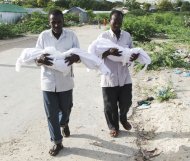Rising hunger in south Ethiopia despite lush green
By LUC VAN KEMENADE - Associated Press | AP – 1 hr 26 mins agoSHEBEDINO, Ethiopia (AP) — Malnourished children are flocking into feeding centers in this forested corner of southern Ethiopia after a drought in East Africa extended into this normally fertile region.
While the famine in southern Somalia has grabbed headlines, southern Ethiopia is teetering on the brink of a food crisis. The Ethiopian government says 250,000 people need food aid amid what the U.N. says is the worst drought in 60 years. An aid organization and agricultural officials say the number of people who need emergency food aid in Ethiopia is bigger, around 700,000.
The rains never came as they usually do late February to the end of May. If they fail again in August, there won't be a harvest in September.
People without food aid will "definitely be in trouble," World Food Program officer Yohannes Desta said. "Do these people have enough resilience to survive? I don't think so."
About 1.3 million southerners received aid earlier this year from a government safety net program that ended in June, said Yohannes Desta, a World Food Program officer. Most of those people, whom Desta calls the "poorest of the poor," still require emergency relief, but instead must scrape by on the few crops they have left or through the goodwill of more fortunate family members or neighbors.
Tsegaye Tilahun, a corn farmer, said he is worried that September won't bring him any yields at all. His previous crops this year ended up being cattle feed after heavy rains destroyed them. After a long dry spell, the plants couldn't absorb the sudden heavy rain.
As a result of losing all his corn and coffee crops, Tsegaye's family went hungry. His daughter Eskael became dangerously underweight and he brought her to a government-run feeding center in Shebedino. He has relied on food handouts for months.
Nurses at a food center in Shebedino, one of many in the region, said they see about 50 severely malnourished children a month. A year ago an average of only six underfed children received treatment there per month.
Berhanu, a 1½-year-old baby, has twig-thin arms and weighs half of what he should. Shundure Tekamo, a mother of six, brought Berhanu to the feeding center for the second time in six months.
"I'm caught in a dilemma," she said. "I want to save my child but who is feeding my children at home?"
Shundure said there was no food to feed them when she left home and she expects her husband to come up with an alternative to "improve our life."
This ethnically diverse region is overpopulated. Most families have six or more people, but farmers till only tiny, state-owned plots.
Farmers should diversify crops and have smaller families, Yohannes said. The Ethiopian government, which is giving out cash to the hungry as food reserves have dwindled, prefers to resettle southern farmers to less densely populated and more fertile areas, mostly hundreds of miles (kilometers) away. This year 86 farmers from Shebedino who the government says have volunteered for resettlement have been moved to Benchmaji in the southwest of Ethiopia.
While the authorities claim the resettled farmers are better off, Yohannes questions its success. "The problem is that people get resettled to places with a different culture and different agricultural practices," he said.
While chopping with his machete at a false banana tree stem — an edible, drought-resistant plant indigenous to Ethiopia's south — to feed his donkey, Tessema Naramo said he is one of the few villagers whose children don't face malnutrition. Tessema is an 80-year old farmer and father of nine. His oldest is 37. The youngest is 5.
"The weather has changed and ruined my harvest in the last couple of years, so I diversified my crops," he said. Next to the usual corn and coffee, he planted banana and avocado trees and started growing eucalyptus trees, which people use for firewood or house-building material. It turned out to be a lucrative business.
But now amid the prolonged drought, Naramo is using his crops to feed his own family, "and even that is hardly enough."
With the possibility that things may turn more dire if the rains don't come, it still not clear how many people need food aid here. The government says 250,000 do, though local officials in the south's agricultural bureau asked the government to provide aid to at least 385,000 more people, said Getatchew Lema, a local food security coordinator. The World Food Program says at least 700,000 require emergency relief.
If more rain doesn't come, those numbers will continue to rise, and more aid will be needed from the international community. Aid agencies are already trying to cope with the famine and are seeking more donations.
Across the Horn of Africa, more than 12 million people need food aid. Besides Somalia and Ethiopia, the drought has also hit Kenya and Djibouti.
http://news.yahoo.com/rising-hunger-south-ethiopia-despite-lush-green-094945136.html


Tidak ada komentar:
Posting Komentar